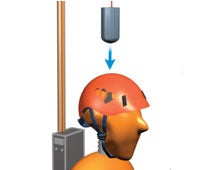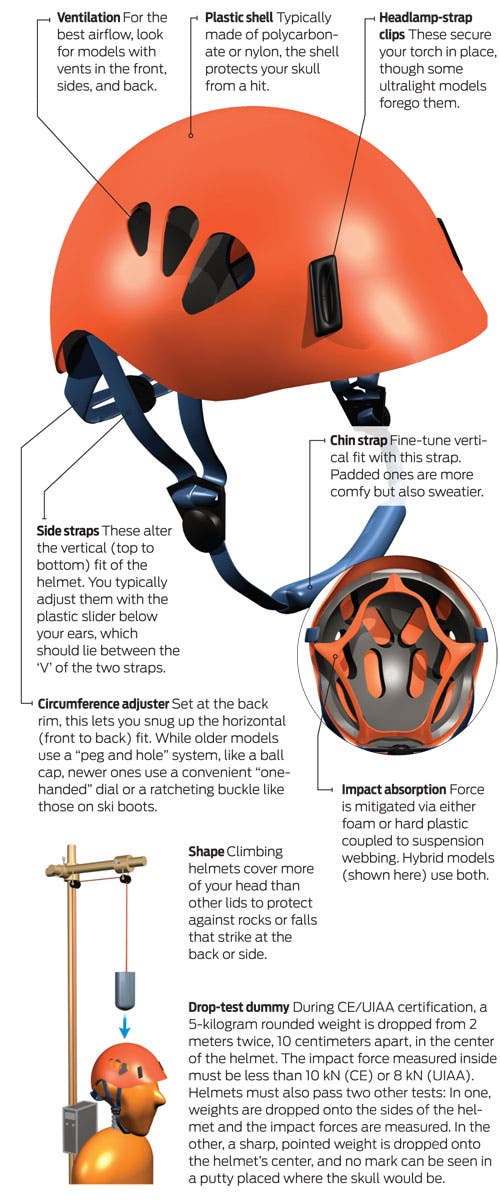Gear School: Helmets

'gearschoolhelmets_200x170'
Buy | USE | MAINTAIN
Illustrations by Don Foley

Technical Details
BUY
>> Types There are three kinds: suspension, foam, and hybrid.
> Suspension Similar to construction-work hard hats, these have an outer shell with an interior webbing system that keeps space between the shell and your head. Upon impact, the plastic deforms, absorbing the force, then typically returns to its previous shape. Hard hats are the most durable of the three types—they withstand abuse and multiple impacts better—and are optimal for frequent or rough use.
> Foam These are made of expanded polystyrene foam covered by a hard shell, similar to bike helmets. The foam absorbs and widely disperses impact force. They tend to be lighter (often weighing half as much as a hard hat), sleeker, and more comfortable. But with their thinner, less-durable shell, they often must be retired after one hit.
> Hybrid Growing in popularity, these domes combine some of the durability of a hard hat with some of the lightweight compactness of foam, though you don’t get the maximum benefit of either feature.
>> Models Everyone’s head is different, so try on many designs. A poor fit can result in the helmet sliding off or pushing up.
>> Conditions Heading to the desert? Suspension models tend to have the most airflow. On ice, look for a sturdier lid, ideally with a face-shield attachment. And make sure you can fit a hat or balaclava underneath. For longer routes, take weight into account.
>> Prices They range from $50-$100. Since hybrids are easier to make, they’re often less expensive than full-foam or full-suspension models.
>> Safety For mountaineering and climbing, use a climbing helmet. Lids meant for cycling and skiing aren’t designed to withstand falling debris and hazards like upside-down falls or horizontal crashes into cliffs.
>> Certification The International Mountaineering and Climbing Federation (UIAA) and the European Community (CE) certifications test a helmet’s impact absorption and penetration resistance. The UIAA standards are more rigorous, and most lids have both certifications. They should be clearly marked on the packaging.
>> Strap adjusters Whether the lid uses push tabs, click wheels, or another mechanism, make sure you can adjust the fit with one hand so you can hold the rock or rope with the other.
USE
>> Fit It should sit squarely on your head, with the front rim straight across your forehead. It should also be snug: Shake your head emphatically side to side, as if saying “No,” and look up and down—the helmet shouldn’t slide around, or it could expose part of your skull to hazards.
>> Field of view Don’t tilt the dome back for visibility, exposing your forehead. Adjust your pack so you can look up without the lid hitting it.
>> Stow Place it in the top of your pack—not on the outside where it can get banged, or at the bottom where gear weight will compress the foam. For similar reasons, don’t sit on your helmet (or your pack, with the helmet inside).
MAINTAIN
>> Store Fasten buckles so they’re less likely to break. Put it in a bag (to protect from abrasions) and keep it in a cool place away from UV rays, chemicals, or direct heat, which break down the plastic shell.
>> Clean Rinse with cool water if dirty or salt-water sopped, then dry.
>> Retire Helmets wear with use and UV rays, so shelve it after a max of 10 years. Climb several times a month? Replace it after five years. If the helmet is damaged (dented, discolored plastic, cracked shell or foam) or it takes a hard hit, retire it.